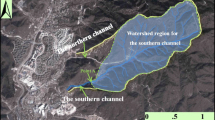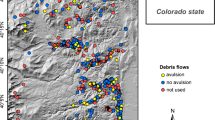Abstract
Cheekye River fan is the best-studied fan complex in Canada. The desire to develop portions of the fan with urban housing triggered a series of studies to estimate debris-flow risk to future residents. A recent study (Jakob and Friele 2010) provided debris-flow frequency-volume and frequency-discharge data, spanning 20-year to 10,000-year return periods that form the basis for modeling of debris flows on Cheekye River. The numerical computer model FLO-2D was chosen as a modelling tool to predict likely flow paths and to estimate debris-flow intensities for a spectrum of debris-flow return periods. The model is calibrated with the so-called Garbage Dump debris flow that occurred some 900 years ago. Field evidence suggests that the Garbage Dump debris flow has a viscous flow phase that deposited a steep-sided debris plug high in organics in centre fan, which then deflected a low-viscosity afterflow that travelled to Squamish River with slowly diminishing flow depths. The realization of a two-phase flow led to a modelling approach in which the debris-flow hydrograph was split into a high viscosity and low viscosity phase that were modelled in chronologic sequence as two separate and independent modelling runs. A perfect simulation of the Garbage Dump debris flow with modelling is not possible because the exact topography at the time of the event is, to some degree, speculative. However, runout distance, debris deposition and deposit thickness are well known and serve as a good basis for calibration. Predictive analyses using the calibrated model parameters suggest that, under existing conditions, debris flows exceeding a 50-year return period are likely to avulse onto the southern fan sector, thereby damaging existing development and infrastructure. Debris flows of several thousand years return period would inundate large portions of the fan, sever Highway 99, CN Rail, and the Squamish Valley road and would impact existing housing development on the fan. These observations suggest a need for debris-flow mitigation for existing and future development alike.










Similar content being viewed by others
References
Baumann FW (1981) Letter to the Ministry of Environment, Lands and Parks
Baumann FW (1991) Report on the Garbage Dump Debris Flow Deposit and its Relationship to the Geologic History of the Cheekye fan. Unpublished report Baumann Engineering, Squamish, BC, 25 pp
Bertolo P, Wieczorek GF (2005) Calibration of numerical models for small debris flows in Yosemite Valley, California, USA. Nat Hazard Earth Syst Sci 5:993–1001
BGC Engineering Inc. (2007a) Cheekye River debris flow frequency and magnitude. Report for Kerr Wood Leidal Associates Ltd. and MacDonald Development Corporation
BGC Engineering Inc. (2007b) Cheekye River debris flow simulation. Report for Kerr Wood Leidal Associates Ltd. and MacDonald Development Corporation
BGC Engineering Inc. (2007c) Cheekye River risk analysis and mitigation optimization. Report for Kerr Wood Leidal Associates Ltd. and MacDonald Development Corporation
Bovis M, Jakob M (1999) The role of debris supply conditions in predicting debris flow activity. Earth Surf Process Landforms 24:1039–1054
Cetina M, Rajar R, Hojnik T, Zakrajsek M, Drzyk M, Mikos M (2006) Case Study: Numerical simulation of debris flow below Stoze, Slovenia. J Hydraul Eng 2:121–130
Clague JJ, Friele PA, Hutchinson I (2003) Chronology and hazards of large debris flows in the Cheekye river basin, British Columbia, Canada. Environ Eng Geosci 8:75–91
Coussot P, Piau JM (1995) A large scale field coaxial cylinder rheometer for the study of the rheology of natural coarse suspensions. J Rheol 39:105–124
Crippen Engineering Ltd. (1974) Report on Geotechnical-hydrological Investigation of the Cheekye Fan. Report to BC Department of Housing, Victoria, BC
Crippen Engineering Ltd. (1975) Cheekye Fan Development Design Report on Proposed Protection Works. Report to BC Department of Housing, Victoria, BC
Crippen Engineering Ltd. (1981) Cheekye Fan Development Report on Hazard Areas and Protective Works. Report to BC Ministry of Lands, Parks and Housing, Victoria, British Columbia
Ekes C, Friele PA (2003) Sedimentary architecture and post-glacial evolution of Cheekye fan, southwestern British Columbia, Canada. In: Bristow, C.S., Jol, H.M. (eds.), Ground Penetrating Radar in Sediments. Special Publication 211. Geological Society of London, pp. 87–98
Ekes C, Hickin EJ (2001) Ground penetrating radar facies of the paraglacial Cheekye fan, Southwestern British Columbia, Canada. Sediment Geol 143:199–217
FLO-2D Software Inc. (2004) FLO-2D Users Manual Version 2004.10, October 2004
Friele PA, Clague JJ (2002a) Readvance of glaciers in the British Columbia coast mountains at the end of the last glaciation. Quat Int 87:45–58
Friele PA, Clague JJ (2002b) Younger dryas readvance in Squamish river valley, southern coast mountains, British Columbia. Quat Sci Rev 21:1925–1933
Friele PA, Clague JJ (2005) Multifaceted hazard assessment of Cheekye fan, a large debris flow fan in Southwestern British Columbia. Chapter 26. In: Jakob M, Hungr O (eds) Debris flow hazards and related phenomenon. Springer-Praxis, Heidelberg, pp 659–683
Friele PA, Clague JJ (2008) Paraglacial geomorphology of quaternary volcanic landscapes in the southern coast mountains, British Columbia. In: Knight J, Harrison S (eds) Periglacial and paraglacial processes and environments, vol 320. Special Publication, Geological Society, London, pp 219–233
Friele PA, Ekes C, Hickin EJ (1999) Evolution of Cheekye fan, Squamish, British Columbia: Holocene sedimentation and implications for hazard assessment. Can J Earth Sci 36:2023–2031
Hutter K, Svendsen B, Rickenmann D (1996) Debris flow modelling: a review. Contin Mech Thermodyn 8:1–35
Iverson RM (1997) The physics of debris flows. Geophysics Review 35:245–296
Iverson RM (2003) The debris-flow rheology myth. In: Rickenmann, D. and Chen Cheng-lung (eds.). Debris flow hazards mitigation: Mechanics, prediction and assessment, 303–314
Iverson R (2009) Elements of an improved model for debris flow motion. Invited contribution for Powders and Grains 2009. American Physical Society
Iverson RM, Vallance JW (2001) New views of granular mass flows. Geology 29(2):115–118
Jakob M, Friele P (2010) Frequency and magnitude of debris flows on Cheekye River, British Columbia. Geomorphology 114:382–395
Jones WC (1959) Cheekye river mudflows. British Columbia Department of Mines, Victoria, 9
Jordan P (1994) Debris flows in the southern Coast Mountains, British Columbia: Dynamic behaviour and physical properties. Unpublished Ph.D. thesis. University of British Columbia. 1994
Kang Z, Zhang S (1980) A preliminary analysis of the characteristics of debris flow. Proceedings of the International Symposium on River Sedimentation. Chinese Society for Hydraulic Engineering, Beijing, pp 225–226
Kerr Wood Leidal (2003) Preliminary design report for Cheekye fan deflection berms. Report for district of Squamish. Squamish, British Columbia
Kerr Wood Leidal (2008) Debris flow mitigation for cheekeye river fan. Report for cheekeye river developments. Squamish, British Columbia
KWL (2003) Preliminary Design Report for Cheekye Fan Deflection Berms. Final report for the District of Squamish. July 2003
Locat J (1997) Normalized rheological behavior of fine muds and their properties in a pseudoplastic regime. In: Chen CL (ed) Debris–Flow Hazards Mitigation: Mechanics, Prediction, and Assessment; Proceedings of the 1st International DFHM Conference, San Francisco, CA, USA, August 7–9, 1997. ASCE, New York, pp 260–269
Major JJ, Pierson TC (1992) Debris flow rheology: experimental analysis of fine-grained slurries. Water Resour Res 28:841–857
Mathews WH (1952) Mount garibaldi, a supraglacial Pleistocene volcano in southwestern British Columbia. Am J Sci 250:553–565
Mathews WH (1958) Geology of the mount garibaldi map area, southwestern British Columbia, Canada. Part II: geomorphology and quaternary volcanic rocks. Geol Soc Am Bull 69:179–198
O’Brien JS, Julien PY (1985) Physical processes of hyperconcentrated sediment flows. Proceedings of the ASCE Specialty Conference on the Delineation of Landslides, Floods and Debris Flow Hazards in Utah, Utah Water Research Laboratory, Series UWRL/g-85/03. 260–279
O’Brien JS, Julien PY (1988) Laboratory analysis of mudflow properties. J Hydraul Eng 114:877–887
Parsons JD, Whipple KX, Simioni A (2001) Experimental study of the grain-flow, fluid-mud transition in debris flows. J Geol 109:427–447
Phillips CJ, Davies TRH (1991) Determining rheological parameters of debris flow material. Geomorphology 4:101–110
Thurber Engineering and Golder Associates (1993) The Cheekye river terrain hazard and land-use study, final report. Report prepared for British Columbia ministry of environment. Lands and Parks, Burnaby
Acknowledgements
Cheekeye River Developments gave permission to publish these results. Oldrich Hungr kindly reviewed a draft and provided helpful comments.
Author information
Authors and Affiliations
Corresponding author
Rights and permissions
About this article
Cite this article
Jakob, M., McDougall, S., Weatherly, H. et al. Debris-flow simulations on Cheekye River, British Columbia. Landslides 10, 685–699 (2013). https://doi.org/10.1007/s10346-012-0365-1
Received:
Accepted:
Published:
Issue Date:
DOI: https://doi.org/10.1007/s10346-012-0365-1




